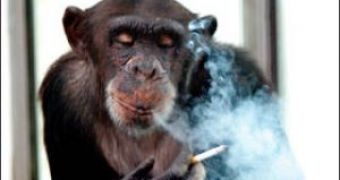Do animals have addictions? Like humans, are they avid of new sensations, of artificial paradises?
For a long time, people have been fascinated by a strange bird behavior called myrmecomany (from Old Greek "myrmex" ant, "mania" obsesion). The bird sits on the soil or on an ant nest, open its wings stretched forward, while it curbs its tail toward its belly. In the first step, the bird lets itself be invaded by angry ants and sometimes they pick ants one by one, squashing them a little bit, to introduce them inside the plumage.
Once fully covered by insects, the bird starts executing some bizarre contortions, coiled movements and spins of the body, keeping the head always risen, the feathers extended, still glance, and saliva over the bill, with an absolutely delighted face. This step lasts roughly 30 minutes. After that, the bird shakes itself to get rid of the ants and if the species eats ants, the bird consumes them.
This behavior has been watched in ravens, jays, thrushes, blackbirds, parrots and many other groups. Scientists supposed that the birds use the formic acid - a very corrosive compound secreted by ants - to clean their plumage out of lice or other parasites or this could be a method to put out the acid from ants before eating them. But some believe that the birds simply impregnate themselves with the pungent substance just to produce pleasure.
In domesticated magpies, this behavior was even more complicated: they took ants and mixed them with tobacco ashes from pipes, after that sloshing their wings with the mixture with the greatest satisfaction.
In northern Australia, red-browed finches were seen to prefer smoke in order to get pleasure. After bush fires, when the finches encounter a smoking trunk, they settle. At the contact with the smoke, finches raised their body, backed on their tail, extending their feathers, starting a left to right circular movement, neck stretched. Soon they got vertigo, loosing balance and falling. The interrupted ceremony was immediately resumed till exhaustion.
In fact, birds have been observed to use a lot of compounds to get pleasure: caterpillar secretions, flour larvae, plant juices, mothballs, ashes, tobacco. Crows have been watched displaying a similar behavior to Australian finches using mothballs and cigarette butts. Scientists noticed that the bird "myrmecomany" vary among individuals, concerning the "compound" chosen (a raven can use green husks of wallnuts while other will choose smoke) and not all the individuals of a species will practice it, most preferring more "natural" pleasures. The variation in "myrmecomany" was greater among the individuals of the same species than between species or bird families. Moreover, individuals never changed their drugging method.
The gestures and contortions can not be understood and explained just by the need of eliminating feather parasites. The birds first dedicated to those activities with passion but after a while renounced little by little as the thing had lost its attractiveness. Sometimes, drugging behavior in birds can be really complex. A lab rook built by straws and twigs a bonfire which it fired using a match (the bird learnt this by itself). The bird displayed a dance with the wings extended; the rook got smoked but not burnt.
But what about mammals? Cats are extremely attracted by the valerian plant (Valeriana officinalis) and catnips (Nepeta cataria), whose sniffing and eating seem to provoke them intense satisfaction. Dogs also enjoy catnips, but they have also a more rough attraction: death corpses. They don't just smell but bowl over death bodies, the contact with the skin and the fur increasing their excitation. The same doggy behavior has been observed in spotted hyenas. A captive coati (a relative of the raccoon) used to slosh its body with a piece of cotton soaked with eau de cologne, after which it dropped over its back dizzy of satisfaction. A domesticated mongoose got the same condition after sloshing itself with chocolate.
Lab mice can even get addicted to chewing tobacco. Not to mention that in many cases pet chimps get addicted to human drugs: tobacco, alcohol and others. And they smoke with style, looking at the smoke rings they eject. Some smaller monkeys were seen to enjoy passive smoking and rub their fur with tobacco ashes overloaded by agitation. They also enjoy garlic, which induces them some kind of dizziness.
Hedgehogs enter many times in the wild in a kind of trance after licking themselves with saliva till it gets foamy. In a case, farmers in an Argentina region noticed their cattle lost appetite and the oxen their working capacity. It was proven that the cattle were not infected, but they ingested some alkaloids from certain plants that acted like strong drugs (in fact, nicotine from tobacco, caffeine from coffee or cocaine are just alkaloids).
Once a year, when the marula fruits ripen, animals in Austral Africa enter a generalized drinking bout as this fruit ferments very easy. Researchers described a crazy situation: all animals around marula tree are drunk, from monkeys to elephants.
All these behaviors previously pointed to do not satisfy any primordial impulse: hunger, reproduction, self-defense. These behaviors enter in contradiction with the self-preservation of the individuals.
The questions that remain are: what incites the animals to brake their powerful preservation instincts? Do they drug themselves consciously?
However, one answer is certain: animals really do seek pleasure and entertainment.

 14 DAY TRIAL //
14 DAY TRIAL //